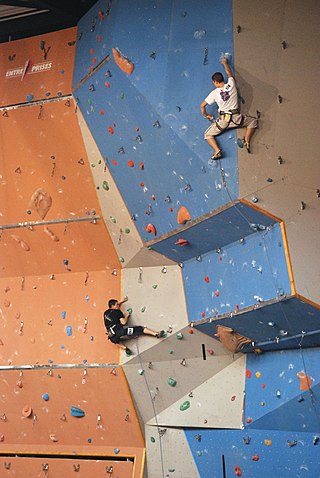
A climbing wall is an artificially constructed wall with grips for hands and feet, usually used for indoor climbing, but sometimes located outdoors. Some are brick or wooden constructions, but on most modern walls, the material most often used is a thick multiplex board with holes drilled into it. Recently, manufactured steel and aluminum have also been used. The wall may have places to attach belay ropes, but may also be used to practice lead climbing or bouldering.

Figure-eight loop is a type of knot created by a loop on the bight. It is used in climbing and caving.
The Flemish loop or figure-eight loop is perhaps stronger than the loop knot. Neither of these knots is used at sea, as they are hard to untie. In hooking a tackle to any of the loops, if the loop is long enough it is better to arrange the rope as a cat's paw.

Glasses, also known as eyeglasses or spectacles, are vision eyewear with lenses mounted in a frame that holds them in front of a person's eyes, typically utilizing a bridge over the nose and hinged arms that rest over the ears.
Climbing protection are mechanical man-made devices employed to reduce the risk and effect of a fall to climbers while on rock or ice. It includes such items as nylon webbing and metal nuts, cams, bolts, and pitons.

A climbing harness is a device which allows a climber access to the safety of a rope. It is used in rock and ice climbing, abseiling, and lowering; this is in contrast to other activities requiring ropes for access or safety such as industrial rope work, construction, and rescue and recovery, which use safety harnesses instead.

Glossary of climbing terms relates to rock climbing, mountaineering, and to ice climbing.
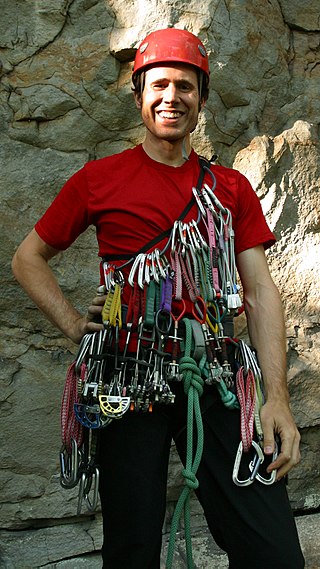
Rock-climbing equipment requires a range of specialized sports equipment, for training, for aid climbing, and for free climbing. Developments in rock-climbing equipment played an important role in the history of rock climbing, enabling climbers to ascend more difficult climbing routes safely, and materially improving the strength, conditioning, and ability of climbers.

Abseiling, also known as rappelling, is the controlled descent of a steep slope, such as a rock face, by moving down a rope. When abseiling, the person descending controls their own movement down the rope, in contrast to lowering off, in which the rope attached to the person descending is paid out by their belayer.

Aid climbing is a style of climbing in which standing on or pulling oneself up via devices attached to fixed or placed protection is used to make upward progress.

Belaying is a variety of techniques climbers use to create friction within a climbing system, particularly on a climbing rope, so that a falling climber does not fall very far. A climbing partner typically applies tension at the other end of the rope whenever the climber is not moving, and removes the tension from the rope whenever the climber needs more rope to continue climbing.
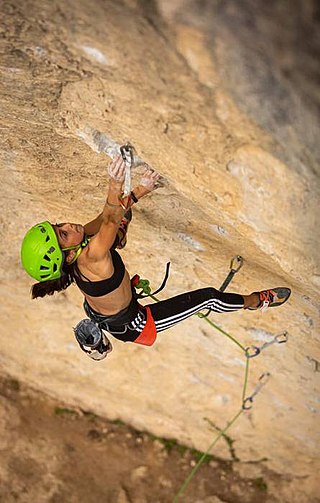
Lead climbing is a technique in rock climbing where the lead climber clips their rope to the climbing protection as they ascend the climbing route, while their second remains at the base of the route belaying the rope to protect the lead climber in the event that they fall. The term is used to distinguish between the two roles, and the greater effort and increased risk, of the role of the lead climber.
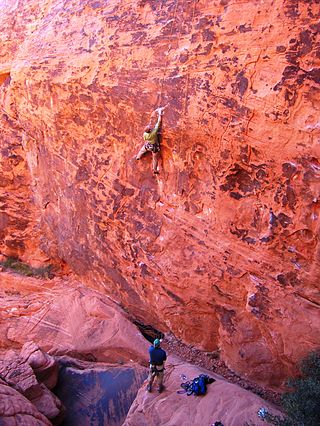
Top rope climbing is a type of rock climbing where the climber is securely attached to a rope that runs through a fixed anchor at the top of the climbing route, and back down to the belayer at the base of the climb. Should the climber fall they will just hang from the rope at the point of the fall. They can then either resume their climb or have the belayer lower them down in a controlled manner to the base of the climb.
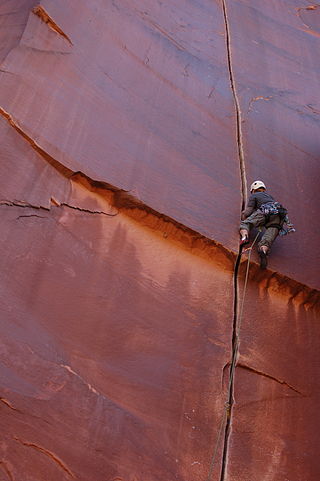
Rock climbing is a sport in which participants climb up, across, or down natural rock formations. The goal is to reach the summit of a formation or the endpoint of a usually pre-defined route without falling. Rock climbing is a physically and mentally demanding sport, one that often tests a climber's strength, endurance, agility and balance along with mental control. Knowledge of proper climbing techniques and the use of specialized climbing equipment is crucial for the safe completion of routes.
Multi-pitch climbing is the ascent of climbing routes with one or more stops at a belay station. Each section of a climb between stops at belay stations is called a pitch. The leader ascends the pitch, placing gear and stopping to anchor themselves to the belay station.

Rope-solo climbing or rope-soloing is a form of solo climbing, but unlike with free solo climbing, which is also performed alone and with no climbing protection whatsoever, the rope-solo climber uses a complex self-belay device and rope system to protect themselves in the event of a fall.

A Grigri is an assisted braking belay device manufactured by Petzl designed to help secure rock-climbing, rappelling, and rope-acrobatic activities. Its main characteristic is a clutch that assists in braking under a shock load. The success of this device has led to grigri becoming a common name for devices of this type. In 2011 a new version, the Grigri 2, was released to replace the original 1991 model. Petzl released the Grigri+ in 2017, adding safety features to the original design, and 2019 saw the release of an updated version of the device, simply called the Grigri. It is named for the African amulet gris-gris, believed to protect the wearer from evil.

A belay device is a mechanical piece of climbing equipment used to control a rope during belaying. It is designed to improve belay safety for the climber by allowing the belayer to manage their duties with minimal physical effort. With the right belay device, a small, weak climber can easily arrest the fall of a much heavier partner. Belay devices act as a friction brake, so that when a climber falls with any slack in the rope, the fall is brought to a stop.

Chicken eyeglasses, also known as chickens specs, chicken goggles, generically as pick guards and under other names, were small eyeglasses made for chickens intended to prevent feather pecking and cannibalism. They differ from blinders as they allowed the bird to see forward whereas blinders do not. One variety used rose-colored lenses as the coloring was thought to prevent a chicken wearing them from recognizing blood on other chickens which may increase the tendency for abnormal injurious behavior. They were mass-produced and sold throughout the United States as early as the beginning of the 20th century.
Eyebuydirect, Inc. is an online retailer of prescription glasses, based in Austin, Texas. The company also sells prescription and non-prescription sunglasses, sport sunglasses, and computer glasses designed to reduce glare. Eyebuydirect was founded in 2005 by Roy Hessel, who was succeeded by Sunny Jiang, chief executive officer since 2017. The company has operations in the United States and China, and sells its products worldwide.


















